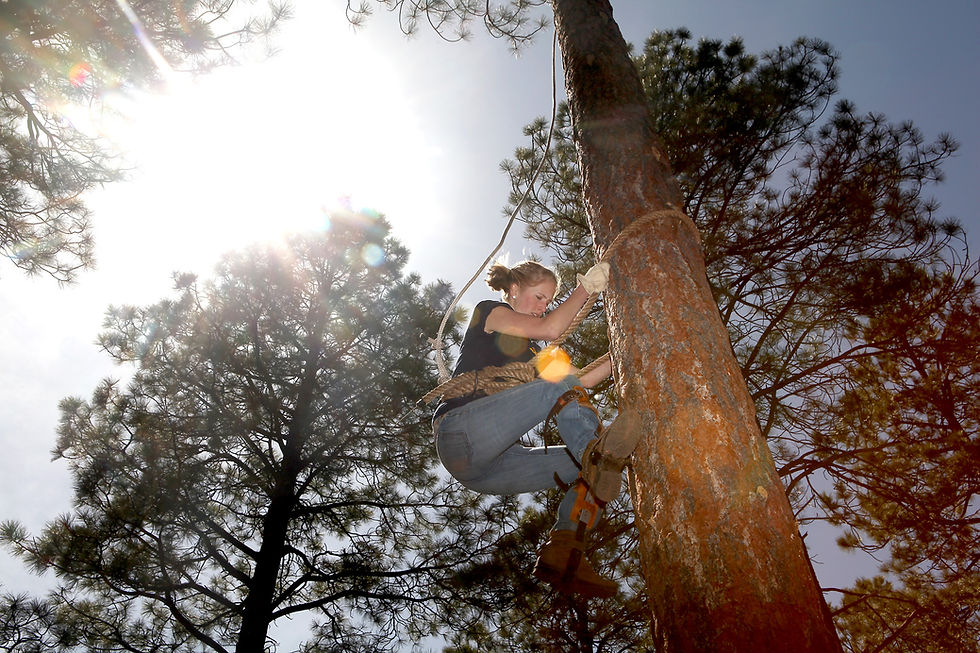The Lumber Games
- bonniestevens7
- Jul 28, 2022
- 4 min read
Updated: Sep 12, 2022

With heart pounding, the teenager struggled to keep her focus on the task at hand, digging her spurs into the skinned tree, reaching the flip line higher around the trunk and pulling herself farther from the safety of the ground as fast as she could in the driving rain. Having watched her competitors drop to their fate under the slippery, strenuous conditions, Katriana Joyce tried not to be distracted as she stretched for the red finish line that marked the end of the race, 30-feet up in the air. Elsewhere in the forest, another young competitor, Casey Branning, was hoisting a heavy, double-bladed axe as far as he could over his head, using all his might to thrust the razor-sharp weapon at his target. These may sound like the life or death challenges in the popular movie, "The Hunger Games," but forestry students have been competing this way for decades. And while "The Hunger Games" may be generating a renewed interest in ancient outdoor sports, Northern Arizona University's School of Forestry students have been practicing these skills in the woods year-round. STRENGTH, AGILITY AND SPEED Joyce, Branning and 14 of their classmates on the NAU Forestry Club Logging Sports Team recently competed against 15 other schools, totaling 187 competitors, in the 73rd Annual Conclave of the Association of Western Forestry Clubs in Corvallis, Ore. The Lumberjacks finished seventh overall. For Joyce, the 45 seconds it took to climb the tree was not fast enough to place in the games. The winner did it in 15. As for those who fell, safety ropes kept them from hurting anything except their chances to win. Like "The Hunger Games," logging sports involve strength, agility, speed and the talent to master seriously sharp tools. But with safety gear in place, the most dire consequence might be falling into 38-degree water. Such is the case in an event known as birling. NAU Logging Sports Team Captain David Gouveia, a stocky 5-foot-8, 200-pound forestry junior from Tucson, has been practicing in icy Lake Mary. Birling involves two competitors standing on a log in a lake. Each struggles to stay upright as it rolls. "It's a very tough event. Not a lot of people can manage to stay up on a spinning log," he said. "It takes strong legs and balance." "It's impossible not to get wet," said teammate Tor Skeen, a junior from southern California. "You're trying to put the other person off balance by changing the direction of the rolling log." For Gouveia, the practice paid off. He placed third in birling at the Conclave. POWER TOOLS, TOO He also took fifth place in the double buck contest with teammate Thomas Roland from Fort Collins, Colo., a forestry sophomore. The double buck involves the two-handled peg and raker crosscut saw, a tool once commonly used by lumberjacks to fell large trees and still used in wilderness areas where motorized equipment is not allowed. "You're sawing together to cut a disc off the end of a 15-inch diameter log and you're doing it as fast as you can," Gouveia said. Gouveia also competed as NAU's representative in the STIHL Timbersports Series, a competition sponsored by the power tool manufacturer in association with the Logging Sports. It involves four events: the single buck using a crosscut saw; the standing block chop; the horizontal or underhand block chop; and the stock saw. "Bucking a log means cutting it into sections so you can move the wood around easier," said NAU Forestry Club freshman Mike Mishler of Tucson. "On the horizontal block chop you're standing on a 26-inch section of wood and dropping an extremely sharp axe between your feet. Because you're wearing steel chainmail socks beneath your boots, you probably won't cut yourself, but you could break a foot." LUMBERJACK REVIVAL The Logging Sports were sanctioned as an official collegiate sport by NAU shortly after the School of Forestry was established in 1958. Forestry students trained and competed for more than 20 years. But around 1982, interest faded and the Lumberjacks Logging Sports Team was no longer sharpening its skills. That was until recently, when Denver Hospodarsky, an NAU forestry professor and Forestry Club faculty adviser, started up the team again. "We've been rebuilding by recruiting team members and acquiring equipment. Five years ago we sent four students to the Conclave. This year we sent 16," he said. "Logging Sports keep skills and traditions alive. It's the only collegiate sport that allows men and women to compete against each other and it also develops leadership skills that separates these students from others." Gouveia says being part of a team enhances the student experience. "The School of Forestry places a large emphasis on community development and it's through these student organizations you see that happen. The club experience offers students a sense of belonging and promotes so much more learning than what takes place inside a classroom." "Having such a team is a tribute to the tradition of logging, which is an important part of our heritage, not to mention an important modern industry," said NAU School of Forestry Executive Director Dr. Jim Allen. "By traveling to the Annual Conclave events, our students see other parts of the western United States, they meet other forestry students, and they can 'show the flag' to the other western forestry schools." For the past two years, Montana's Flathead Community College has placed first overall at the Conclave. But NAU's Forestry Club is conducting fundraising activities to purchase more logging sports equipment and to hire a logging sports veteran to coach the team so that, like in "The Hunger Games," the odds may be forever in their favor.




Comments